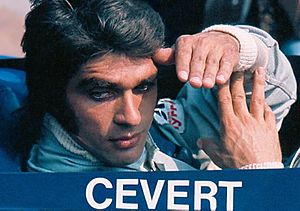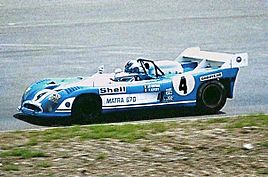François Cevert facts for kids

Francois Cevert, 1973
|
|||||||||||
| Born | Albert François Cevert Goldenberg 25 February 1944 Paris, France |
||||||||||
|---|---|---|---|---|---|---|---|---|---|---|---|
| Died | 6 October 1973 (aged 29) Watkins Glen, New York, United States |
||||||||||
| Formula One World Championship career | |||||||||||
| Nationality | |||||||||||
| Active years | 1969–1973 | ||||||||||
| Teams | Tyrrell | ||||||||||
| Entries | 48 (47 starts) | ||||||||||
| Championships | 0 | ||||||||||
| Wins | 1 | ||||||||||
| Podiums | 13 | ||||||||||
| Career points | 89 | ||||||||||
| Pole positions | 0 | ||||||||||
| Fastest laps | 2 | ||||||||||
| First entry | 1969 German Grand Prix | ||||||||||
| First win | 1971 United States Grand Prix | ||||||||||
| Last win | 1971 United States Grand Prix | ||||||||||
| Last entry | 1973 United States Grand Prix | ||||||||||
|
|||||||||||
Albert François Cevert Goldenberg (born February 25, 1944 – died October 6, 1973) was a talented French racing driver. He competed in Formula One, which is the highest class of international auto racing. During his career, he raced in 48 Grand Prix events, won one race, and finished on the podium (top three) 13 times.
Contents
François Cevert's Family History
François Cevert was the son of Charles Goldenberg, a jeweler from Paris, and Huguette Cevert. His father, Charles, was from a Russian-Jewish family who moved to France when he was young. They left Russia to escape the unfair treatment of Jewish people.
During World War II, when Nazi Germany occupied France, Charles joined the French Resistance. This was a group that secretly fought against the occupation. He did this to avoid being sent away because he was Jewish. To protect their children, Charles and Huguette registered all four of them with Huguette's last name, Cevert. Years later, after France was free, Charles wanted to change their names back to Goldenberg. However, the family decided against it because they were already well-known as Cevert.
François Cevert was also related to another Grand Prix driver, Jean-Pierre Beltoise. Jean-Pierre was his brother-in-law.
Racing Journey: From Scooters to Formula One
Starting on Two Wheels
François Cevert began his racing journey at 16, not with cars, but with motorcycles. He started by racing his mother's Vespa scooter against his friends. When he was 19, he got his own Norton motorcycle.
After finishing his National Service, Cevert decided to switch to car racing. In 1966, he took a training course at the famous Le Mans racing school. Then, he joined the Winfield Racing School at the Magny-Cours track. At Winfield, he won a special scholarship called the Volant Shell. The prize was an Alpine Formula Three car.
Formula Three and Formula Two Success
His first year in Formula Three with the Alpine car was tough. He didn't have enough money or experience to keep his car in top shape. But in 1968, he found a sponsor and got a better car, a Tecno. With this new car, Cevert started winning races. By the end of that season, he became the French Formula 3 Champion.
After winning the Formula 3 title, Cevert joined the Tecno team for Formula Two in 1969. He finished third overall in that championship. He also drove in the F2 class of the 1969 German Grand Prix. Back then, Formula Two was a great place for young drivers to learn. Many top Formula One drivers also raced in F2 when they had time.
A famous story tells how Jackie Stewart, a Formula One champion, had trouble passing Cevert in an F2 race. Stewart told his team manager, Ken Tyrrell, to watch out for the young Frenchman. This advice paid off in 1970. When Tyrrell needed a new driver quickly, Stewart's recommendation was still in his mind. Tyrrell later said that people thought he hired Cevert because of the French oil company Elf, who sponsored his team. But he said it was really because of what Jackie Stewart had told him.
Joining Formula One with Tyrrell
In 1970, Johnny Servoz-Gavin suddenly left the Tyrrell Formula One team. Tyrrell then asked Cevert to be his second driver, racing alongside the reigning World Champion, Jackie Stewart. Over the next four seasons, Cevert became like a student to the experienced Stewart.
Cevert made his Formula One debut at the Dutch Grand Prix at Zandvoort. He drove a March-Ford car for Tyrrell. With each race, he got faster and closer to Stewart's pace. He scored his first World Championship point by finishing sixth at the Italian Grand Prix in Monza.
In 1971, the Tyrrell team started building their own cars. Cevert finished second in races in France and Germany. Both times, he finished right behind his team leader, Stewart.
Cevert made history by becoming only the second Frenchman to win a Formula One World Championship Grand Prix. The first was Maurice Trintignant, who won in Monaco in 1955 and 1958. Cevert's big win came at the 1971 United States Grand Prix. This was the highlight of his career. It helped him finish third in the 1971 Drivers' Championship, behind Stewart and Ronnie Peterson.
The year 1972 was not as successful for Cevert, Stewart, and Tyrrell. Cevert only scored points in three races. He finished second in Belgium and the USA. He also came fourth at his home race in France. One good moment for Cevert that year was finishing second at the 1972 24 Hours of Le Mans race. He drove a Matra-Simca 670 car with his teammate, Howden Ganley.
A Tragic End at Watkins Glen
In 1973, the Tyrrell team was back on top in Formula One. Cevert showed he could race just as well as Stewart in almost every event. He finished second six times that year. Three of those times, he was right behind Stewart. Jackie Stewart later said that Cevert was a very "obedient" teammate.
As Cevert's driving skills became equal to Stewart's, Stewart was secretly planning to retire after the last race of the season in the United States. This meant that for the 1974 season, Cevert would become the main driver for the Tyrrell team.
However, tragedy struck at Watkins Glen. During a qualifying session on Saturday morning, Cevert was trying to get the fastest lap time. He was battling for pole position with Ronnie Peterson. In a fast section of the track called "The Esses," Cevert's car went a little too far to the left. It hit the kerbs (the raised edges of the track). This made the car swerve to the right, where it hit the blue safety barriers. The car then spun and crashed into the barriers on the other side of the track at a sharp angle. The impact was so severe that it uprooted and lifted the barrier. François Cevert died instantly from his injuries.
Jackie Stewart was one of the first people to arrive at the scene of Cevert's accident. He later said that the marshals had left Cevert in the car because it was clear he had died. Stewart immediately left the scene and went back to the pits.
News of the serious crash slowly reached the pit area. Other team members and even Lotus owner Colin Chapman went to the Tyrrell pit where Stewart had parked his car. Chapman was told by his team manager that Cevert was involved and it was "very bad." When Stewart got out of his car, Chapman understood from his sad expression that it was a fatal accident. He sighed and walked slowly back to his own team's pits.
Emerson Fittipaldi, another driver, also parked his car and got out without speaking. He later called Cevert's death "one of the saddest [days] of my career."
Because of François Cevert's death, the Tyrrell team decided not to race in that Grand Prix. This meant Jackie Stewart did not race what would have been his final and 100th Formula One race.
François Cevert was 29 years and 224 days old when he died. He is buried in the Cimetière de Vaudelnay in the village of Vaudelnay, France.
What Caused the Accident?
After the accident, Jackie Stewart went out on the track in his own car to understand what happened. He concluded that he preferred to drive through "The Esses" in fourth gear. This made the car more stable and less jumpy, even if it meant being a bit slower. Cevert, however, liked to use third gear. This would give him more power, but it also made the car harder to control in that tricky section. Stewart noted that the Tyrrell car always felt a bit unstable through "The Esses" because it had a short wheelbase. He felt that driving in a higher gear helped with this, even if it meant losing a little time if he didn't get the line perfect.
A film documentary from that time shows Stewart and Cevert having a lively discussion about this exact point just minutes before the fatal practice session. Another accident happened at the same track a year later in the 1974 USA Grand Prix. Another young Formula One driver, Helmuth Koinigg, died when his car crashed into a barrier. Because of Cevert's and Koinigg's accidents, a chicane (a sharp bend added to slow cars down) was put in "The Esses" in 1975. This chicane was removed in 1985 after the track stopped hosting Formula One races.
Films Featuring François Cevert
- The 2013 movie Rush shows a scene that combines details from Cevert's fatal accident.
- The 2013 documentary 1: Life on the Limit also talks about Cevert's fatal accident in 1973.
- Cevert was also featured and interviewed in the Formula One documentary, The Quick and the Dead.
Racing Achievements
François Cevert had many notable achievements in his racing career:
- Winner of the Volant Shell scholarship in 1966
- French Formula 3 Champion in 1968
- Third place in the Formula 2 European Championship in 1969
- Third place in the Formula 1 Drivers' World Championship in 1971
- Second place in the 24 Hours of Le Mans race in 1972
- Winner in Donnybrook, Can-Am series in 1972
- Winner of the 1000km of Paris race in 1970
Images for kids
See also
 In Spanish: François Cevert para niños
In Spanish: François Cevert para niños
- List of select Jewish racing drivers






